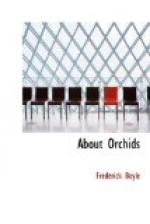The auctioneer has been chatting among his customers. He feels an interest in his wares, as who would not that dealt in objects of the extremest beauty and fascination? To him are consigned occasionally plants of unusual class, which the owner regards as unique, and expects to sell at the fanciest of prices. Unique indeed they must be which can pass unchallenged the ordeal of those keen and learned eyes. Plumeria alba, for instance, may be laid before them, and by no inexperienced horticulturist, with such a “reserve” as befits one of the most exquisite flowers known, and the only specimen in England. But a quiet smile goes round, and a gentleman present offers, in an audible whisper, to send in a dozen of that next week at a fraction of the price. So pleasant chat goes on, until, at the stroke of half-past twelve, the auctioneer mounts his rostrum. First to come before him are a hundred lots of Odontoglossum crispum Alexandrae, described as of “the very best type, and in splendid condition.” For the latter point everyone present is able to judge, and for the former all are willing to accept the statements of vendors. The glossy bulbs are clean as new pins, with the small “eye” just bursting among their roots; but nobody seems to want Odontoglossum Alexandrae in particular. One neat little bunch is sold for 11s., which will surely bear a wreath of white flowers, splashed with red brown, in the spring—perhaps two. And then bidding ceases. The auctioneer exclaims, “Does anybody want any crispums?” and instantly passes by the ninety-nine lots remaining.




